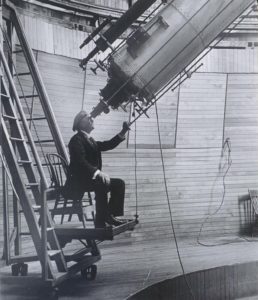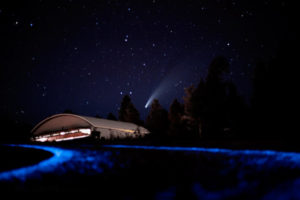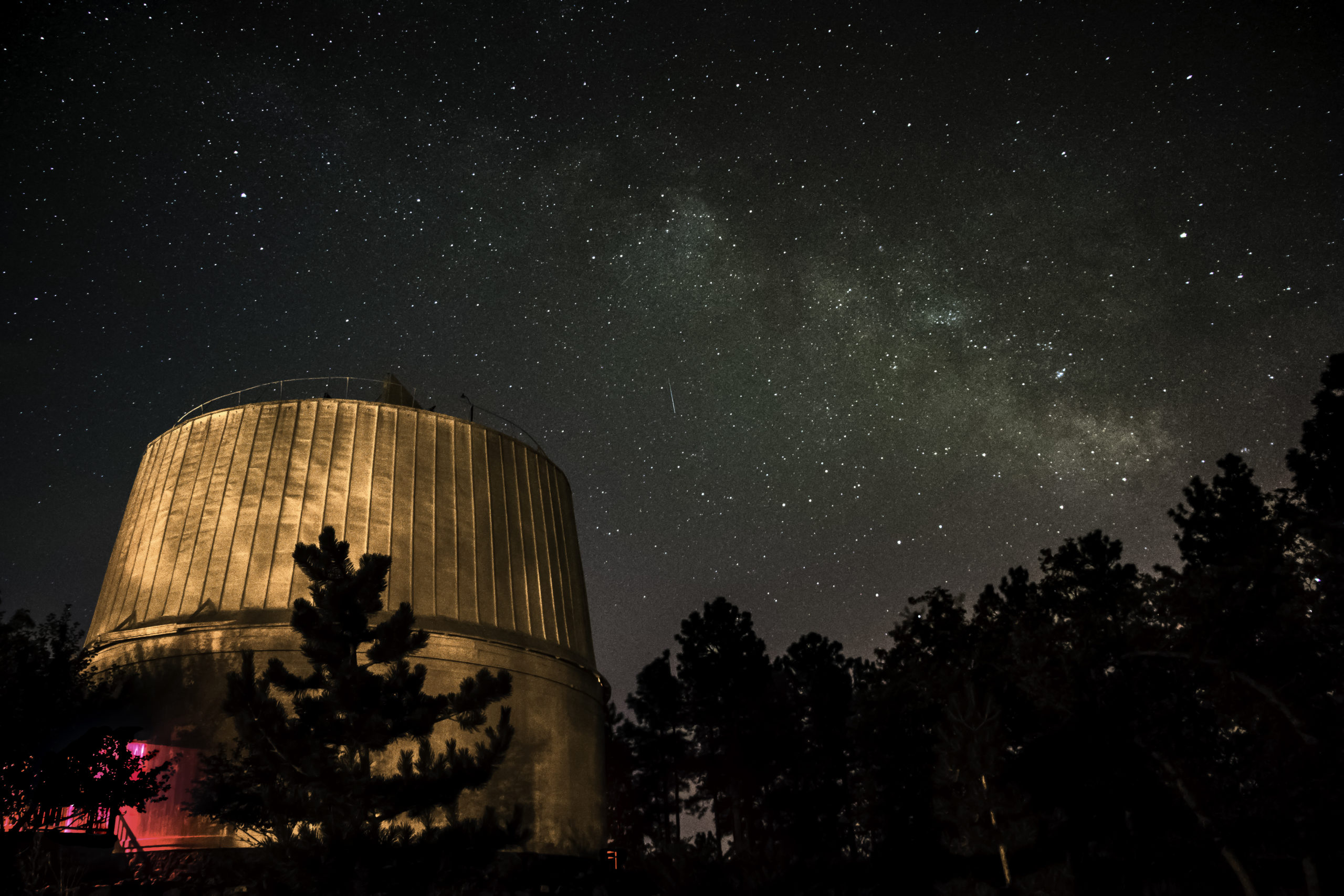Historical Timeline
Wow, just think of all the great discoveries and research here – the 9th planet, the expanding universe, searching for life on Mars, mapping the Moon for the Apollo missions, planets around other stars, and so much more!
Hours
Weather
The mission of Lowell Observatory is to pursue the study of astronomy, especially the study of our solar system and its evolution; to conduct pure research in astronomical phenomena; and to maintain quality public education and outreach programs to bring the results of astronomical research to the general public.
Land Acknowledgement
Lowell Observatory sits at the base of mountains sacred to tribes throughout the region. We honor their past, present, and future generations, who have lived here for millennia and will forever call this place home.
Lowell Observatory will be a place where people are happy and proud to work, and one where outsiders are complimentary and respectful of its staff and volunteers and their accomplishments.
Support Lowell Observatory
Share in connecting the community with the cosmos through Lowell Observatory.

Percival Lowell established his observatory on May 28, 1894, initially to study Mars and the possibility of intelligent life there. He transcended science into pop culture by writing several popular books and lecturing widely. His provocative ideas triggered much discussion and debate—both within and outside of scientific circles—about extraterrestrial life.
This standard set by Lowell to pursue scientific studies and share the wonder and awe of space with the public led to the observatory’s dual mission of research and education, which Lowell Director Jeff Hall explains can really be boiled down to, “communicating science – that is really what we do, whether through our excellent research program or when we welcome guests to our visitor program.”
Today, scientists at Lowell use a variety of ground- and space-based instruments for research—including the observatory’s flagship Lowell Discovery Telescope, one of the most versatile telescopes in the world. Meanwhile, more than 100,000 visitors come to our Mars Hill campus each year to explore space for themselves by looking through telescopes, gazing at the star-spangled skies as educators point out celestial features, and listening to experts explain the wonders of the cosmos.
Our visitor program has become so popular that we are bursting at the seams with crowds of knowledge-seeking guests. So what do we do to accommodate this? In 2019 we opened the Giovale Open Deck Observatory, a state-of-the-art observing plaza with 6 telescopes for guests to explore space. And that’s just the beginning.

In 2024, we will also open our new Astronomy Discovery Center, which will feature a roof-top “open planetarium”. Rather than a traditional enclosed planetarium in which guests view images of celestial bodies, this one takes advantage of Flagstaff’s exquisitely dark skies to look at the real thing—stars and their celestial buddies in their natural setting.
The observatory has also played a leading role in dark skies protection, with Lowell astronomers urging the Flagstaff City Council to create a lighting ordinance in 1958—the first in the world. Years later, in 2001, the International Dark-Sky Association named Flagstaff the world’s first International Dark Sky City because of this community’s ongoing commitment to protecting the quality of its dark skies.
In recognition of Lowell’s heritage of science, education, culture, and history, the observatory was designated a Registered National Historic Landmark by the National Park Service in 1965 and identified as an Arizona Treasure in 2005 by Governor Janet Napolitano; included in 1999 by First Lady Hillary Clinton in her Save America’s Treasures program; and named by Time magazine in 2011 as one of “The World’s 100 Most Important Places.” Astronomy magazine Editor Dave Eicher has nicknamed Lowell Observatory “America’s Observatory” because of its “unique combination of astronomical history and famous discoveries”.

More than 45,000 nights have passed since the first telescope arrived on Mars Hill. In that time, Lowell astronomers have been at the forefront of astronomical research. It was here that Clyde Tombaugh discovered Pluto in 1930 and V.M. Slipher first detected the expanding nature of the universe nearly two decades earlier.
That tradition continues today with the observatory’s state-of-the-art Lowell Discovery Telescope and the ongoing discoveries being made by the current generation of Lowell astronomers and planetary scientists.
Every planet, star, and galaxy has a unique story to tell, and Lowell scientists are internationally recognized experts at revealing and interpreting those stories.
Current research at Lowell is remarkably diverse. Some Lowell scientists study the Sun, planets, comets, asteroids and other members of the solar system. Others study the life cycles of stars and the planetary systems orbiting them. Still others explore galaxies, mysterious dark matter, and the farthest reaches of the universe.
Lowell astronomers, postdoctoral researchers and students publish dozens of research papers in leading scientific journals every year and this work is supported by millions of dollars in research grants from NASA, the National Science Foundation, the Marley Foundation, and other generous gifts from donors.
While much of this research makes use of the observatory’s telescopes in the Flagstaff area, Lowell scientists also use other major facilities around the world and in space, including the Hubble Space Telescope and more.
Additionally, Lowell astronomers are key members of space missions such as the New Horizons flyby of Pluto and Arrokoth, and use cutting-edge experimental facilities such as the Astrophysical Materials Lab at Northern Arizona University to learn more about the properties of these icy worlds. The Navy Precision Optical Interferometer at nearby Anderson Mesa is a unique collaborative effort between the U.S. Naval Observatory, the Naval Research Laboratory and Lowell. It combines the light collected by multiple telescopes to achieve extremely high-precision measurements that surpass anything possible with a single telescope.
Lowell Observatory is known for its legacy of cutting-edge research ranging from detection of the first evidence of the expanding universe in 1912 and discovery of Pluto in 1930, to modern-day studies of the solar system and beyond with one of the world’s most powerful tools for exploring space, the Lowell Discovery Telescope. The observatory is also a center for informal science education, with recent surges in visitation demonstrating the public’s desire to seek out activities that allow them to experience wonder and awe. In itself, this dual identity of Lowell—as a research center that also educates and entertains guests—makes for a unique story and is shared elsewhere here. But there is much more, because Lowell has accomplished this not as a lone organization isolated from the rest of northern Arizona, but as an active, dedicated member of the community.
Lowell has in many ways grown up alongside Flagstaff. Both the city and the observatory trace their beginnings to the southeastern side of the mesa known today by locals as Mars Hill. It was here that the original town site of Flagstaff—established in 1884—was located. “Downtown” was later moved a mile to the east, where the flatter grade proved easier for outgoing trains trying to gather speed. Ten years after Flagstaff’s founding, and only three years after Coconino County was established, Percival Lowell’s assistant, Andrew Douglass, climbed to the top of that same mesa on a cool day in April to observe the quality of the air for telescopic viewing. This was the 11th site he had tested in Arizona, with a goal of finding an ideal location to build Lowell’s observatory. Site 11 proved the most suitable of all the places Douglass had tested in Flagstaff, as well as in Tombstone, Tucson, Tempe and Prescott. Douglass decided to build the facility a half mile to the north of Site 11, where the slope up the mesa was gentler and thus more ideal to build a road upon. When word got out that Flagstaff was the chosen location for the new observatory, 82 community members signed a letter pledging their support. The names represent a who’s who of Flagstaff pioneers—Babbitts, Riordans, Brannens, and others—and the gesture triggered a long, mutually beneficial relationship between the community and observatory.
Lowell and Flagstaff followed parallel, often crossing, paths on their journeys to maturity. As Flagstaff celebrated the growth of Arizona that led to statehood in 1912, Lowell astronomer V.M. Slipher detected the first evidence of the expanding universe. Clyde Tombaugh’s 1930 discovery of Pluto brought unprecedented media attention to Flagstaff, resulting in increased visitation to the area that, like the rest of the country, was suffering through the Great Depression. Such Lowell-related attention has been repeated through the years, with examples including the New Horizons spacecraft’s flyby of Pluto in 2015 and the “Great American Eclipse” of 2017. Visitation not only benefits Lowell but also, of course, Flagstaff in general, with restaurants, hotels, and other attractions all profiting from resulting income. And this will increase in coming years as Lowell embarks on an unprecedented era of expansion to its visitor experience.
The intertwined development of Lowell alongside Flagstaff is evident in other ways. Lowell was the community’s first permanent scientific establishment and helped pave the way for other research organizations to come here to study the area’s rich array of natural resources. Four years after the observatory opened its doors, the first weather station in Flagstaff was established, run by Elizabeth Renoe, wife of future U.S. Senator Henry Fountain Ashurst. Additional research centers followed through the years: the country’s first forest research station, known today as the Fort Valley Experiment Station, in 1908; the Museum of Northern Arizona in 1928; the Atmospheric Research Station at today’s Northern Arizona University in 1952; the U.S. Naval Observatory Flagstaff Station in 1955; the Astrogeology Branch of the U.S. Geological Survey in 1963; and many more. Then there are Northern Arizona University and Coconino Community College, where research is combined with preparing tomorrow’s scientists, and the Flagstaff Festival of Science, the oldest continuously running free science festival in the western hemisphere. All this adds up to science as a major component of the foundation on which Flagstaff is built.
While Lowell helped pave the way for the development of Flagstaff as a scientific community, it also played a leading role in a related effort—establishing the city as a dark skies community. In 1958, scientists at Lowell prepared to add a large telescope to its fleet of research instruments (this, the Perkins Telescope, was the fifth largest in the world at the time; coincidentally, 60 years later, the Lowell Discovery Telescope is the fifth largest telescope in the continental United States). Such an instrument called for the darkest observing conditions possible, and so the scientists talked with members of Flagstaff’s city council, who enacted a regulation limiting the use of searchlights in the area. This was the world’s first lighting ordinance and served as the first step in establishing Flagstaff as a leader in dark sky protection. In 1989, Coconino County passed the world’s first law restricting both the type of light and amount of light per acre, and in 2001 the International Dark-Sky Association (IDA) recognized these ongoing efforts by naming Flagstaff the world’s first International Dark Sky City. IDA Executive Director David Crawford said at the time, “No other city or town has shown such an overall commitment to protecting the quality of its dark skies, not only for the observatories, but for all the citizens of northern Arizona.”
Like any organization, Lowell Observatory is only as good as the people working there. And Lowell has been home to generations of exemplary employees, so many of whom have recognized the value of serving not only their employer but their community. Astronomer E.C. Slipher set a great example, serving on numerous committees and boards around town and even taking on the duties of mayor from 1918-1920. One of the co-founders of United Way of Northern Arizona was Bernice Giclas, onetime employee at Lowell and astronomer Henry Giclas’s wife. Astronomer Nat White was a founding board member of Coconino Community College and also served on the Flagstaff City Council, and many other observatory staff members have played leading roles in community matters. Much of this may be attributed to the sense of ownership Lowell staff feel for the community and the observatory. Director Emeritus Bob Millis captured the observatory’s unwritten philosophy about this when recalling a statement by longtime Director John Hall (no relation to current director Jeff). When a staff member mentioned being an employee of Lowell, Hall responded, “You don’t WORK FOR Lowell Observatory, you ARE Lowell Observatory.”
During these past 125 years, Lowell Observatory has been recognized as a Registered National Historic Landmark by the National Park Service and an Arizona Treasure by Arizona Governor Janet Napolitano; included by First Lady Hillary Clinton in her Save America’s Treasures program; and named by Time magazine in 2011 as one of “The World’s 100 Most Important Places.” If you name a science education show—from Walt Disney’s Tomorrowland Program in the 1950s to modern-day specials on the Science Channel—chances are Lowell, and by extension Flagstaff, have been featured.
The last century-plus has been a great ride for Lowell as both a research institution and member of the Flagstaff community. Yet we see this as just the foundation for what is yet to come. Stay tuned!